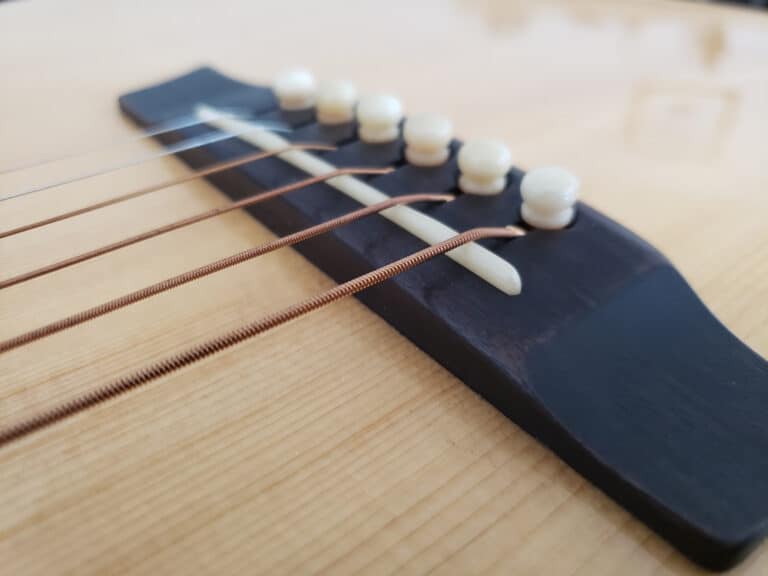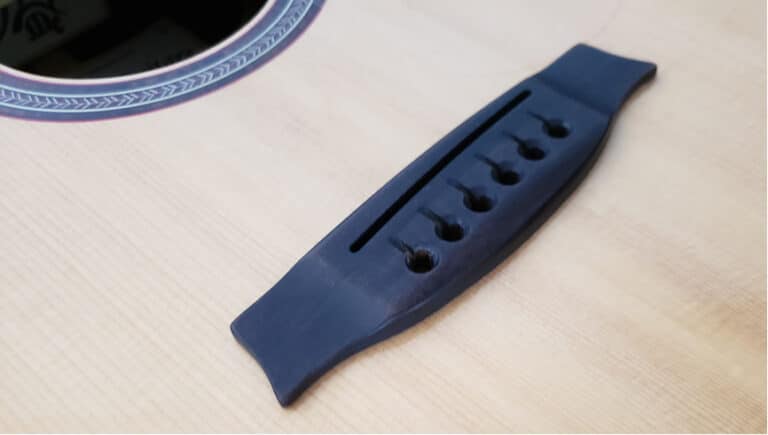What Acoustic Guitar Saddle Height Do I Need?

Wondering which acoustic guitar saddle height you need? Please check the height for your current saddle. The saddle heights that we offer are common starting points, but not factory set heights that require no adjustment. Each guitar will have a slightly different neck angle, and so although the factory might set the twelfth fret action at a specified height, this can be achieved through a combination of adjusting the neck relief, nut slot height, or saddle height, resulting in different saddle heights for different guitars.
Additionally, each guitar’s saddle will have different heights for either side. Please see our article on How to Adjust Saddle Height on One Side More than the Other. Our saddle types are often made with a height variation of around 1.0 to 1.2 mm between the bass and treble sides.
To determine what saddle height you need, please remove your current saddle and measure your saddle’s height from the bottom of your current saddle to where the strings rest at the treble E and bass E strings on the saddle top, as well as the maximum height, then compare to the specs listed on our saddle information pages.

What if My Acoustic Guitar Is Missing the Saddle?
Unfortunately, there is no set height for a saddle, even from the factory. Each guitar will have a slightly different neck angle, and so although the factory might set the action at a specified height, this can be achieved through a combination of adjusting the neck relief, nut slot height, or saddle height. If your guitar’s saddle is missing, trying to determine the height needed for a new saddle on your own will be difficult. You may not know whether the saddle needs to be adjusted, or the neck relief, or the nut slots, or a combination of those. Rather than spending a great deal of time and burning through several saddles, we advise that you take your guitar to a qualified guitar technician.
However, if you wish to install a new saddle and adjust the height on your own, try the following. Please note that the below assumes that no changes need to be made to the neck relief, nut slots, or bass to treble height difference on the saddle, which is unlikely.
First install a new saddle without changing the height. The action might be very high, but now you have a starting point to work from. Measure your twelfth fret action height. Action height depends on your playability and tonal preferences. Typically, though, the best move is to get the twelfth fret action at 7/64″ on the bass side and 5/64″ on the treble side. If this is too high and uncomfortable, lower to 6/64″ on the bass side and 4/64″ on the treble side. For most people, this height range is the best mix of good tone and playability. It does not need to be these exact measurements, though. You might find that you have something such as 6/64″ on the bass side and 5/64″ on the treble side. If you are happy with the tone and playability, do not worry about achieving exact measurements.
Go slowly and remove a little bit of saddle material at a time, reinstall the saddle, and check measurements and playability, then repeat as needed. There’s a good chance that you will sand your new saddle a bit too much and get buzzing, so plan to have at least one back up saddle. Please see our article on how remove the saddle to make adjustments without completely restringing for tips.
If you get to around 6/64″ on the bass side and 4/64″ on the treble side and still want to improve playability, we advise that you not reduce action height further as this can lead to buzzing and poor tone. Please see our article on low guitar action without buzzing for more information, which includes tips on improving playability beyond lowering the action.
